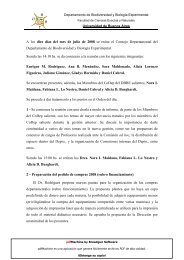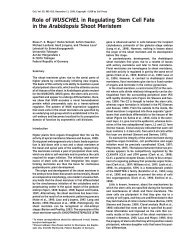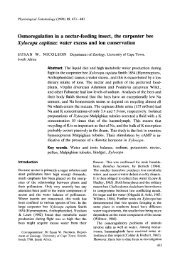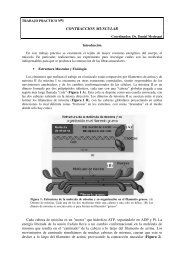The Aerobiology Pathway
The Aerobiology Pathway
The Aerobiology Pathway
You also want an ePaper? Increase the reach of your titles
YUMPU automatically turns print PDFs into web optimized ePapers that Google loves.
Spores of certain fungi are released seasonally rather than throughout the year and<br />
the timing of spore release can be monitored and ideally predicted if a good understanding<br />
of climatic effects on fruiting body development and sporulation is established.<br />
Often seasonal release of fungal plant pathogen spores is synchronised finely to coincide<br />
with a particular growth stage of the host plant e.g. spores of Claviceps purpurea (Pl.<br />
8.15), (which causes ergot of cereals and grasses) and Venturia inaequalis (Pl. 8. 16),<br />
(which causes apple scab) are both released around the time of flowering of their hosts.<br />
Studies of spores by Last (1955) within wheat and barley crops infected by mildew<br />
Blumeria graminis (Erysiphe graminis), revealed a daily periodicity in spore release. Air at<br />
different levels above the ground and at different times of the day was sampled with a<br />
portable, manually operated volumetric spore trap (Gregory, 1954). <strong>The</strong> most abundant<br />
fungal spores in the air on a dry day were Blumeria, (Pl. 10.30), Cladosporium (Pl.<br />
11.1-2), and Alternaria (Pl. 11.3-6), with a peak in numbers at 16.00 GMT, while<br />
Sporobolomyces (Pl. 10.5) and Tilletiopsis (Pl. 10.4) were most numerous at 04.00 GMT.<br />
After rain, as well as Sporobolomyces and Teletiopsis, there were many spores tentatively<br />
identified as ascospores. It is thought that these periodic differences in the air spora profile<br />
reflect different mechanisms of spore release with maximal numbers of dry-spores<br />
and pollen released in late afternoon.<br />
Other studies have since confirmed that ascospores are usually released after wetting<br />
by rain or dew, the water creating turgor pressure to force the ascospores from the ascus<br />
individually in some species or otherwise in one go. Although associated with rain,<br />
spore trapping experiments showed that most ascospores were released after rainfall, for<br />
up to five days, while the crop debris bearing apothecia was still wet. ‘Leaf’ wetness and<br />
‘Debris’ wetness sensors were used to monitor the crop and debris. Tests in a miniature<br />
wind tunnel showed that under wet-dry cycles, spores could be produced for as long as<br />
21 days, the largest numbers ejected whilst the debris was drying (McCartney and<br />
Lacey, M., 1990). Similarly, ascospores of Leptosphaeria maculans (phoma stem canker,<br />
Pl. 8.3) were released after rain, and on wet debris had a diurnal periodicity (possibly<br />
due to changes in relative humidity), most spores being released around 10 am -12 midday<br />
(West et al. 2002a).<br />
2.2. Pollen release<br />
In gymnosperms and angiosperms, pollen release is passive, with the flower parts raised<br />
into more turbulent air and anthers of anemophilous angiosperms often extended on<br />
long filaments into the airflow. Compared to insect-pollinated plants, large numbers of<br />
relatively small pollen grains are produced by anemophilous plants to ensure that some<br />
pollen will reach the intended target. Pollen from plants considered to be insectpollinated<br />
can in some cases become airborne, e.g. oilseed rape pollen and may lead to allergy<br />
problems, but generally, pollen of entomophilous plants represent a low proportion of<br />
airborne pollen e.g.


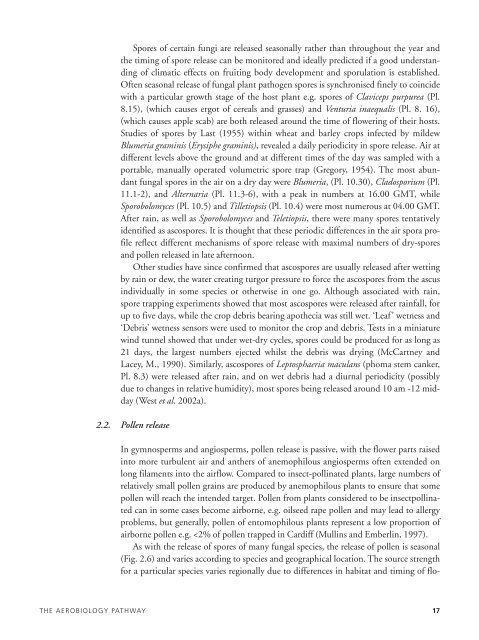

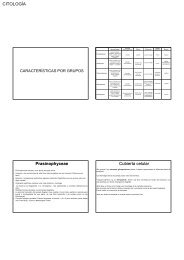


![Estructuras secretoras internas [4.64 MB]](https://img.yumpu.com/14294979/1/190x143/estructuras-secretoras-internas-464-mb.jpg?quality=85)
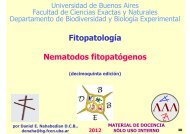
![anatomía y exomorfología [7.14 MB]](https://img.yumpu.com/12744163/1/190x143/anatomia-y-exomorfologia-714-mb.jpg?quality=85)
